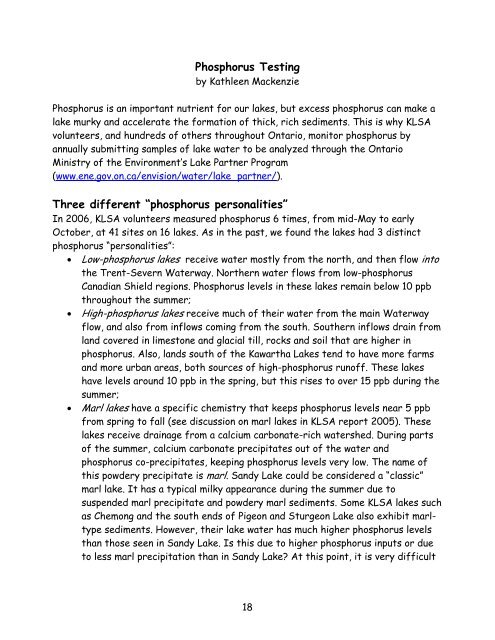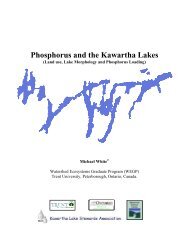Lake Water Quality 2006 Report - Lakefield Herald
Lake Water Quality 2006 Report - Lakefield Herald
Lake Water Quality 2006 Report - Lakefield Herald
You also want an ePaper? Increase the reach of your titles
YUMPU automatically turns print PDFs into web optimized ePapers that Google loves.
Phosphorus Testingby Kathleen MackenziePhosphorus is an important nutrient for our lakes, but excess phosphorus can make alake murky and accelerate the formation of thick, rich sediments. This is why KLSAvolunteers, and hundreds of others throughout Ontario, monitor phosphorus byannually submitting samples of lake water to be analyzed through the OntarioMinistry of the Environment’s <strong>Lake</strong> Partner Program(www.ene.gov.on.ca/envision/water/lake_partner/).Three different “phosphorus personalities”In <strong>2006</strong>, KLSA volunteers measured phosphorus 6 times, from mid-May to earlyOctober, at 41 sites on 16 lakes. As in the past, we found the lakes had 3 distinctphosphorus “personalities”:• Low-phosphorus lakes receive water mostly from the north, and then flow intothe Trent-Severn <strong>Water</strong>way. Northern water flows from low-phosphorusCanadian Shield regions. Phosphorus levels in these lakes remain below 10 ppbthroughout the summer;• High-phosphorus lakes receive much of their water from the main <strong>Water</strong>wayflow, and also from inflows coming from the south. Southern inflows drain fromland covered in limestone and glacial till, rocks and soil that are higher inphosphorus. Also, lands south of the Kawartha <strong>Lake</strong>s tend to have more farmsand more urban areas, both sources of high-phosphorus runoff. These lakeshave levels around 10 ppb in the spring, but this rises to over 15 ppb during thesummer;• Marl lakes have a specific chemistry that keeps phosphorus levels near 5 ppbfrom spring to fall (see discussion on marl lakes in KLSA report 2005). Theselakes receive drainage from a calcium carbonate-rich watershed. During partsof the summer, calcium carbonate precipitates out of the water andphosphorus co-precipitates, keeping phosphorus levels very low. The name ofthis powdery precipitate is marl. Sandy <strong>Lake</strong> could be considered a “classic”marl lake. It has a typical milky appearance during the summer due tosuspended marl precipitate and powdery marl sediments. Some KLSA lakes suchas Chemong and the south ends of Pigeon and Sturgeon <strong>Lake</strong> also exhibit marltypesediments. However, their lake water has much higher phosphorus levelsthan those seen in Sandy <strong>Lake</strong>. Is this due to higher phosphorus inputs or dueto less marl precipitation than in Sandy <strong>Lake</strong>? At this point, it is very difficult18





